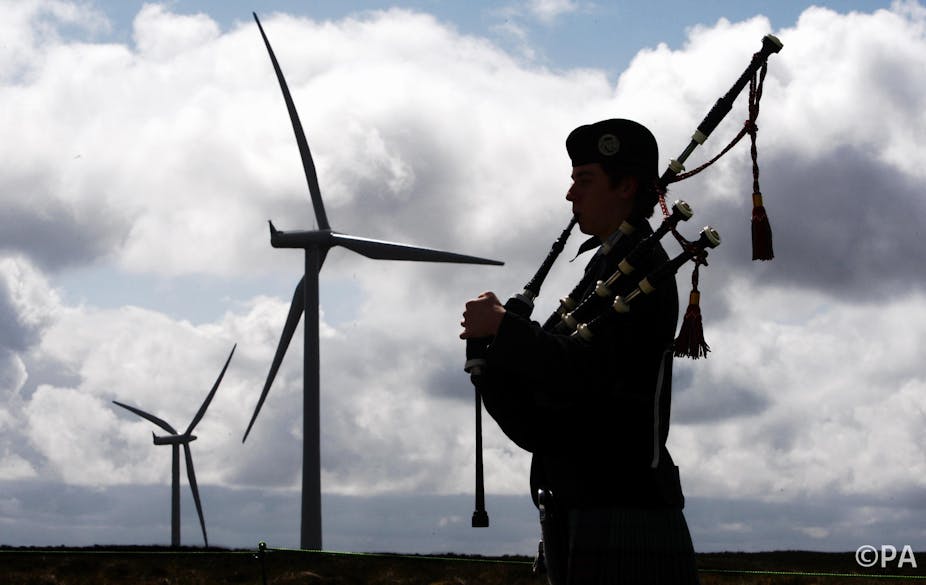A frequent claim heard is that the UK is Europe’s windiest country. This is a partial truth; Scotland is the windiest country, whereas England is far from the windiest.
To see the truth of this one need only consider the performance of onshore wind energy developments. Here, the measure of their efficacy is called the capacity or load factor. In Scotland the rolling annual average is almost 30%. In England it is 23.5%. For the UK overall it is 26.5%, dragged down by England. So official UK planning guidance (Planning Policy Statement 22) is wrong to claim the UK average is 30%, as are other claims between 20% to 50%.
In 2010 nearly two-thirds of England’s onshore wind farms failed to achieve 20% load. In 2009 and 2011 about one-third of developments in England failed to make 20%. In England in 2010, which was not a windy year, the average performance was only 18.7%. In Scotland only a quarter of developments failed to reach a capacity factor of 20% in 2010, and only about 10% fell below that level in 2009 and 2011.
As some involved in wind energy developments would admit, not all Scottish schemes have been well located in relation to the local wind resource. But the record is far better than in England. Even in a relatively windy area of England – Cumbria – two schemes placed 2.3 kilometres apart have performed very differently. Lowca has achieved a rolling capacity factor of 29.5%, whereas nearby Siddick has only achieved 19.4%. These figures, by the way, are provided by the wind energy developers themselves.
But even more infuriating has been the deluge of wind energy development proposals in Central England and East Anglia where mean wind speeds are low. Apart from visual impact and loss of property value there has been a serious misallocation of resources. Wind turbines and their ancillary equipment are mostly produced abroad (about 80% on average), involve exploitation of some rare materials, and if carbon emissions were calculated on a national consumption basis would have an even poorer claim to avert carbon emissions than developers usually claim.
On top of all this, population density in England is about 408 people per square kilometre, contrasted with Scotland’s 65. Although population density is only a very rough indicator of population distribution, the contrast should serve as a warning signal to developers, planners, and policymakers alike. It does not seem to have done so over the past 20 years.
Scotland, of course, has a far better hydropower resource base than England (outside the Lake District), and also a considerable potential for pumped storage for back-up to the intermittency of wind power. David MacKay in his book: Sustainable Energy – without the hot air, identified 13 Scottish lochs with large potential for pumped storage.
Scotland also has enviable potential for tidal stream and wave power to produce electricity. There are those who would like to build estuarine barrages from the Severn to the Solway Firth. People have been on about this since 1849. But the impact on over-wintering and migratory birds would be catastrophic, as they would be unable to access the invertebrates they need from mudflats. Only the Severn would produce a significant volume of electricity (though probably only about half the 5% of current annual UK electricity demand claimed). Tidal stream has the further cost and resource-input advantage that it does not require dams to be built.
The real concern is the visual impact major onshore wind energy developments may have on the beautiful Scottish landscape. As someone who has climbed many Munros, spent fascinating times in and around bothies in the snow-bound Cairngorms, and walked across Rannoch Moor on the wettest day for 70 years, this is a worry for me. But then so also are the planning decisions in England which permit the simple burning of palm oil in electricity-generating plants, claims from planning inspectors that wind energy developments can achieve 100% capacity factors, and other evidence of a shambolic state of affairs.
In reality the UK authorities are banking on institutions having their own back-up generating capacity, plus combined heat-and-power and gas-fired generation, which rely upon fossil fuels in the short-term to offset the risk of the lights going off. Attempted back-stops all too familiar in developing countries.
Scotland has very clear advantages over England in onshore wind, hydro, pumped storage, and tidal stream resources - all should be tapped for the UK to meet it’s target of generating 15% of its energy and 30% of its electricity from renewable sources by 2020. The best achieved so far is 4% of primary energy supply and (in one quarter in 2012) 11.2% of its electricity.
The reality is that the UK imported 24% more coal last year than in 2011 (the highest since 2006) as US shale gas drove down its coal export prices. That a world of renewable energy will come this century seems a very forlorn hope, if the poorly focused policies and investments in the UK (not least in England) are replicated elsewhere.

